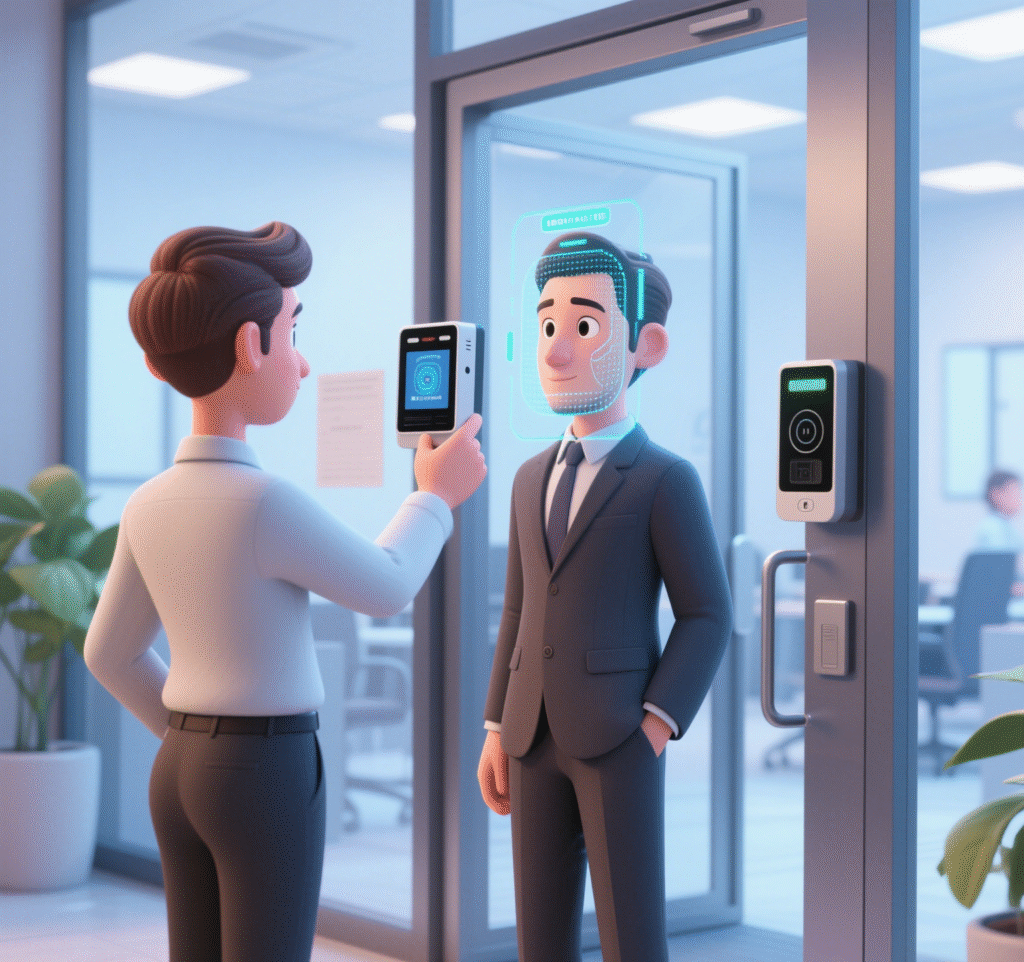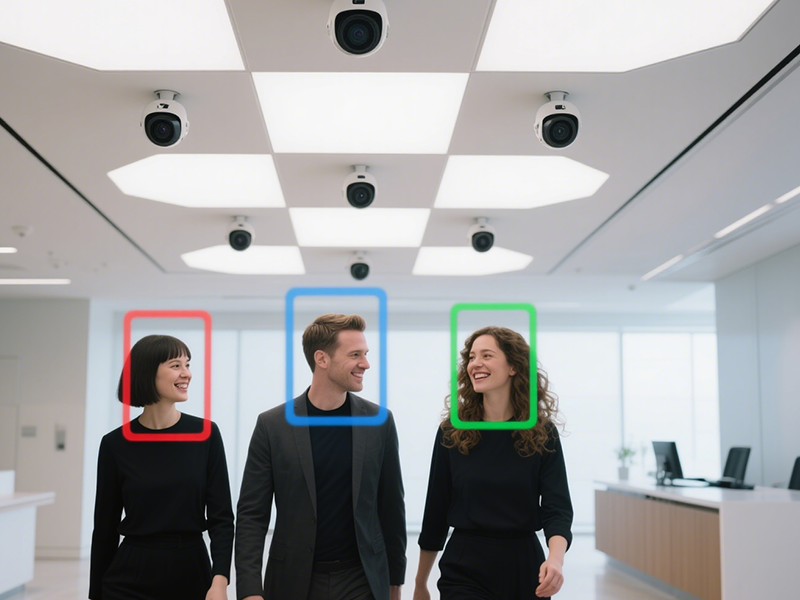What is Live Facial Recognition?
Live facial recognition is an advanced biometric technology that identifies and verifies individuals by analyzing their unique facial features in real time. Unlike traditional face recognition systems, which can be fooled by photos or videos, live facial recognition uses liveness detection to ensure that the subject is a real person, not a spoofing attempt.
By leveraging AI algorithms, 3D depth sensing, and infrared scanning, the system can distinguish between a live face and a static image, providing a higher level of security and accuracy.
How Live Facial Recognition Works
Live facial recognition is a sophisticated technology that identifies and verifies individuals by analyzing their facial features in real time. The process generally involves several key steps:
1.Image Capture
The system begins by capturing a high-quality image or video of the person’s face using a camera. Modern facial recognition systems often employ infrared or 3D cameras in addition to standard RGB cameras to handle varying lighting conditions, reduce shadows, and enhance accuracy. This ensures that the system can accurately detect faces even in dim or overly bright environments.
2.Feature Extraction
Once the face is captured, the system analyzes and extracts unique facial features. This includes measurements such as the distance between the eyes, nose shape, jawline, cheekbone contours, and other biometric landmarks. These features are converted into a mathematical representation called a “facial template” or “faceprint,” which serves as a unique identifier for that individual.
3.Liveness Detection
To prevent spoofing attacks using photos, videos, or masks, advanced systems employ liveness detection. This step examines subtle cues such as blinking, head movements, facial expressions, micro-expressions, skin texture, and even blood flow patterns beneath the skin. By analyzing these indicators, the system ensures that the face being scanned belongs to a live person rather than a static image or artificial replica.
4.Matching & Verification
After confirming the face is live, the system compares the extracted facial template with existing templates stored in a secure database. Sophisticated algorithms calculate similarity scores to verify identity. Depending on the application, this step can either authenticate the person (confirm they are who they claim to be) or identify them (match against a large database to find their identity).
5.Real-Time Performance
All of these steps—image capture, feature extraction, liveness detection, and matching—occur in a fraction of a second. This ultra-fast processing makes live facial recognition ideal for real-time applications, including access control, attendance management, security screening, and border control.
Benefits of Live Facial Recognition
Live facial recognition technology offers a range of advantages for businesses, institutions, and public spaces. Its benefits extend beyond basic identification, improving security, convenience, and operational efficiency.
Contactless Process
Unlike fingerprint scanners or card readers, live facial recognition is entirely contactless. Users do not need to physically touch any device, which provides a hygienic solution—especially important in healthcare, laboratories, and public facilities where hygiene and safety are critical. The contactless nature of the system also reduces wear and tear on hardware and eliminates the need for physical tokens.
تعزيز الأمن
Live facial recognition significantly increases security by preventing unauthorized access. Unlike traditional systems that rely on PINs, ID cards, or fingerprints, modern facial recognition systems integrate advanced liveness detection to block spoofing attacks using photographs, videos, or 3D masks. This ensures that only legitimate, live individuals are granted access, reducing the risk of identity theft and enhancing overall protection for sensitive areas.
Fast Verification
The technology operates in real time, allowing rapid identification and verification of individuals within milliseconds. This speed ensures smooth and uninterrupted access to secure areas, making it ideal for high-traffic environments such as airports, corporate offices, educational campuses, and event venues. By minimizing delays, organizations can maintain operational efficiency while upholding strict security standards.
Scalability and Integration
Live facial recognition systems are highly scalable and can be seamlessly integrated into existing security infrastructure. They can work with access control systems, employee attendance management platforms, mobile applications, and visitor management solutions. This flexibility allows organizations to deploy facial recognition technology across multiple locations and for diverse use cases without significant infrastructure changes.
Applications of Live Facial Recognition
Access Control Systems – Used in offices, airports, and stadiums for secure entry.
Time & Attendance Tracking – Automates employee check-in and check-out with accuracy.
الخدمات المالية – Enables secure online banking and mobile payment authentication.
Public Security & Law Enforcement – Helps identify suspects and enhance surveillance.
Healthcare & Education – Improves patient verification and student attendance monitoring.


Challenges and Considerations of Live Facial Recognition
While live facial recognition offers significant benefits, organizations must be aware of its challenges and implement measures to address them responsibly. Proper understanding of these considerations ensures effective deployment while maintaining trust and compliance.
Privacy and Data Protection
Live facial recognition involves processing sensitive biometric data, which raises privacy concerns. Organizations must comply with international and local regulations, such as the General Data Protection Regulation (GDPR) in the EU, CCPA in California, or other regional data protection laws. It is essential to implement secure data storage, encryption, and controlled access, while obtaining explicit consent from individuals whose data is being collected. Transparent privacy policies and clear communication about how facial data is used are critical to maintaining user trust.
Accuracy Across Different Environments
Environmental factors such as poor lighting, strong sunlight, or extreme weather conditions can affect the accuracy of facial recognition systems. Indoor and outdoor deployment may require specialized cameras, infrared sensors, or adaptive algorithms to ensure consistent performance. Organizations must conduct thorough testing in diverse settings to minimize false positives or false negatives, ensuring reliable identification under all conditions.
Ethical Use and Bias Prevention
Ethical considerations are essential in deploying live facial recognition. Systems must be designed to prevent misuse, discrimination, or bias against certain demographic groups. Algorithms should be regularly audited to ensure fairness and inclusivity, avoiding disparities in recognition rates based on race, age, or gender. Clear usage policies, employee training, and accountability measures help organizations use facial recognition responsibly.
Technical and Operational Challenges
Implementing facial recognition requires proper integration with existing security or attendance systems, robust network infrastructure, and regular maintenance. Organizations must plan for software updates, hardware calibration, and system scalability to support growing user bases. Training staff to manage and troubleshoot the system is also crucial for optimal performance.
Public Perception and Acceptance
Even with secure and ethical practices, public perception can influence the acceptance of facial recognition technology. Clear communication about its purpose, benefits, and security measures can alleviate concerns. Engaging stakeholders, addressing community feedback, and demonstrating transparency in data handling foster trust and encourage adoption.
Future of Live Facial Recognition
As AI and sensor technology continue to evolve, live facial recognition will become even more accurate and accessible. With applications in smart cities, digital identity, and border control, this technology is shaping the future of secure authentication and real-time verification.
التعليمات
Live facial recognition includes اكتشاف الفعالية, ensuring the system can distinguish a real face from a photo or video, providing higher security.
Yes. It uses advanced encryption and secure databases, making it safe for personal and enterprise applications when deployed responsibly.
Modern systems use infrared sensors and AI algorithms, allowing them to work in both low-light environments and under strong sunlight.
Industries such as banking, healthcare, education, government, and corporate enterprises benefit significantly from enhanced security and efficiency.
It stores encrypted templates of facial features, not the actual photo, ensuring privacy and compliance with global data protection standards.
اتصل بنا
We would love to speak with you.
Feel free to reach out using the below details.


